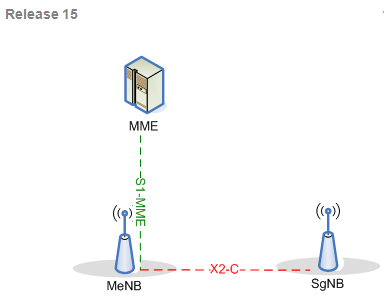 In the first part of this series, I emphasized that in 3GPP Release 15, a major focus is to get a first incarnation of 5G into the field that complements 4G LTE. Instead of today’s approach where a device is either connected to GSM, or to UMTS or to LTE, i.e. only to one technology at a time, things will be different in 5G. Due to the higher frequencies bands used and other reasons (see part 1) it was deemed better to enable mobile devices to connect to LTE and 5G New Radio (NR) simultaneously. This is referred to as Dual Connectivity EN-DC. So how will this work in practice?
In the first part of this series, I emphasized that in 3GPP Release 15, a major focus is to get a first incarnation of 5G into the field that complements 4G LTE. Instead of today’s approach where a device is either connected to GSM, or to UMTS or to LTE, i.e. only to one technology at a time, things will be different in 5G. Due to the higher frequencies bands used and other reasons (see part 1) it was deemed better to enable mobile devices to connect to LTE and 5G New Radio (NR) simultaneously. This is referred to as Dual Connectivity EN-DC. So how will this work in practice?
The VCFB Vintage Computing Festival Berlin – 7.-8. October 2017
An event I’ve been looking forward to for a long time is this year’s Vintage Computing Festival Berlin (VCFB) which takes place in about one and a half weeks from now, Saturday and Sunday on the 7th and 8th October 2017 in the German Museum of Technology in Berlin. If you are even only remotely interested in the history of computing and you are anywhere near Berlin over that weekend, it is the event to attend! Unlike in previous years when the dates did not fit into my travel calendar it is a perfect match this year. And best of all for me, I did not only decide to go but I will also bring a small exhibit of my own!
Continue reading The VCFB Vintage Computing Festival Berlin – 7.-8. October 2017
What Fails First in The Future? Plastics vs. Electronics
Recently I had to retire two electronic gadgets, a mouse and a speaker. It happens, you might say, electronics doesn’t live forever. True, but in these cases it was the first time that I had to retire devices not because their electronics failed, but because of the plastic outside that has started to become soft and sticky! Both the mouse and the speaker were still functioning properly and I used them almost everyday. Quite sad to see and a real waste!
5G – Part 2 – Some Thoughts On Network Slicing
One of the new features of 5G networks is ‘Network Slicing’. So far I couldn’t really get my head around the concept, everything I heard was just too abstract to make practical sense. Finally, however, things are getting more concrete and 3GPP TS 38.300 has an interesting section of how network slicing will work on the radio network side of 5G. Let’s have a closer look.
Continue reading 5G – Part 2 – Some Thoughts On Network Slicing
Intel Discontinues Their 802.11ad Notebook Cards – The End Of WiGig?
As Anandtech says ‘in a surprise move’ Intel has announced last week that they will discontinue their 60 GHz WiGig + Wifi + Bluetooth cards. As they were pretty much the only ones selling WiGig connectivity options for notebooks so far I can’t help but wonder if this move has just spelled the end for moving to mmWave spectrum in the home and enterprise domain!?
Just the other day I’ve read another article I read somewhere tat touted that 5G is about to move to where Wifi has already gone. And now Intel buries it. Let’s hope 5G doesn’t follow that example as well. But even if it doesn’t, it just shows what kind of a rocky ride mmWave frequencies are and will also be for 5G. Massive MIMO, beam-forming, beam-sweeping and lots of other technology innovations are necessary to make it work. Compared to that, the move from 3G WCDMA to LTE OFDMA was childs play.
5G – Part 1 – A First Look Into The TS’es
Two and a half years ago in March 2015 I had my first post on 5G on this site about 3GPP kicking off its 5G activities. A lot has happened since then and I had the occasional post but now things are getting really exciting for me: Various 3GPP groups have started churning out the first drafts of Technical Specifications (TS) rather than refining the many different implementation options discussed in many different 3GPP Technical Reports (TR). In other words the technical specifications are now written based on the agreed-on options from the TRs. So now is the time to have a first look what is going to be put into practice.
Like the GPU, WiFi Now Moves Into The Intel CPU
Once upon a time a CPU in a notebook was just the central processing unit and all other functionality like memory controler, graphics, high speed buses, Ethernet controller, Wifi, etc. could be found in external chips. Many of those chips were produced and owned by companies other than Intel or AMD. Over time, as more and more functionality could be put into a single chip, many of the afore mentioned functionalities moved into the x86 CPU and the surrounding Intel chipset. In 2010 Intel took a major step and included the graphics processor, the GPU, in their chipset. This pretty much killed the mass market for stand-alone GPUs and since then, Nvidia (GeForce) an AMD (Radeon) GPUs are mostly used in gaming and special application PCs, i.e. in niche markets. Now it looks like Intel has taken the next step and the 2017 evolution of the Core-i processors will now also include the digital part of the Wifi controller.
Continue reading Like the GPU, WiFi Now Moves Into The Intel CPU
Freifunk – Sharing My Internet Connectivity While On Vacation – Part 2
This post continues the tale of my Freifunk experience I had while spending a week on a castle in Germany. In this part I’ll have a closer look at the performance of my network node and how it was used during the time I ran it at the castle.
Continue reading Freifunk – Sharing My Internet Connectivity While On Vacation – Part 2
Freifunk – Sharing My Internet Connectivity While On Vacation – Part 1

I recently went on vacation for a week to a castle in Germany which is a bit off the beaten path. The castle and surroundings are beautiful but I knew from a previous trip that their Wifi Internet connectivity is not available in all rooms. However, I also knew that LTE coverage is quite o.k. in the area so I wasn’t particularly worried about connectivity and instead thought about how I could safely share my Internet connectivity with others while being there.
Continue reading Freifunk – Sharing My Internet Connectivity While On Vacation – Part 1
Instant Printer Detection and Use In Ubuntu 16.04
There have been the days no matter on which operating system when installing the driver for a new printer was a real pain. Linux has been no exception and it was probably the platform on which this procedure was the most painful. After all, especially companies that are on the cheap side of the market often don’t bother to provide printer drivers for Linux so it’s up to the community to do that. I’ve come quite a number of different printers from different manufacturers over the years and I can’t remember a single one that wouldn’t work after a bit of configuration. While the added effort is obviously a disadvantage the big plus is that community drivers prevent closed source software from invading your system and keep bloatware and advertising pop-ups away from your system.
HP is one of the positive and notable exceptions in the Linux world. Their open source driver suite for their printers and scanners works well indeed, comes as a part of many Linux distributions and I had very good experiences with it over the years when I had to connect to HP products. Recently, I noticed that things have advanced a step further (in Ubuntu 16.04 which I am using right now but it is most likely included in other distributions as well) as the HP printer I connected to my notebook over USB was detected automatically and drivers were installed without any user interaction. No model selection, no questions. Perfect!
